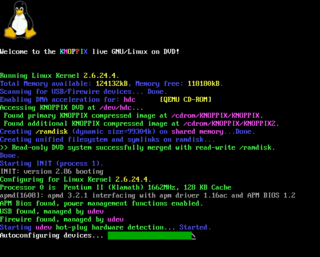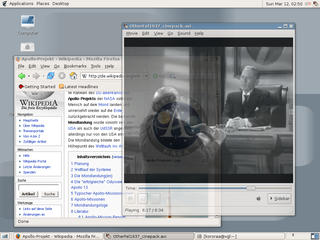See also
- Direct Rendering Manager
- KMS driver
- General Graphics Interface
- Linux framebuffer
- SVGAlib, a low-level graphics library which runs on Linux and FreeBSD
| Original author(s) | Denis Oliver Kropp |
|---|---|
| Stable release | 1.7.7 / February 1, 2015 |
| Repository | github |
| Written in | C [1] |
| Operating system | Linux, macOS |
| Type | Library |
| License | LGPL |
| Website | DirectFB web (archive.org) |
| Developer(s) | Nicolas Caramelli |
|---|---|
| Repository | github |
| Website | directfb2 |
DirectFB (Direct Frame Buffer) is a software library with a small memory footprint that provides graphics acceleration, input device handling and abstraction layer, and integrated windowing system with support for translucent windows and multiple display layers on top of the Linux framebuffer without requiring any kernel modifications. [2] [3] DirectFB is free and open-source software subject to the terms of the GNU Lesser General Public License (LGPL).
The library allows developers an alternative to a full X Window System (X11) server used in Unix-like operating systems. DirectFB allows applications to talk directly to video hardware through a direct API, speeding up and simplifying graphic operations.
It is often used by games and embedded systems developers to circumvent the overhead of a full X Window System server implementation.[ citation needed ] In 2006, a version of DirectFB was included in the software stack for the CE Linux Forum's Audio/Video Graphics Specification V2. [4]
DirectFB can host XDirectFB, a rootless X server implementation that uses DirectFB windows for X11 top-level windows. XDirectFB is an interface that mimics the X11 interface through the DirectFB API to simplify running applications written for X11 on DirectFB. [5]
DirectFBGL is an OpenGL extension for DirectFB/XDirectFB that uses Direct Rendering Infrastructure (DRI) in the Mesa 3D library to support OpenGL hardware acceleration.
Among the products that use DirectFB are LinuxTV, Ben Nanonote, the unreleased Palm Foleo mobile companion, the webOS operating system, Panasonic Viera Connect TVs and the Philips TVs based on jointSPACE. [6]

OpenGL is a cross-language, cross-platform application programming interface (API) for rendering 2D and 3D vector graphics. The API is typically used to interact with a graphics processing unit (GPU), to achieve hardware-accelerated rendering.

The Linux framebuffer (fbdev) is a linux subsystem used to show graphics on a computer monitor, typically on the system console.

In computing, a windowing system is a software suite that manages separately different parts of display screens. It is a type of graphical user interface (GUI) which implements the WIMP paradigm for a user interface.
freedesktop.org (fd.o), formerly X Desktop Group (XDG), is a project to work on interoperability and shared base technology for free-software desktop environments for the X Window System (X11) and Wayland on Linux and other Unix-like operating systems. Although freedesktop.org produces specifications for interoperability, it is not a formal standards body.
X.Org Server is the free and open-source implementation of the X Window System (X11) display server stewarded by the X.Org Foundation.
GLX is an extension to the X Window System core protocol providing an interface between OpenGL and the X Window System as well as extensions to OpenGL itself. It enables programs wishing to use OpenGL to do so within a window provided by the X Window System. GLX distinguishes two "states": indirect state and direct state.
The X video extension, often abbreviated as XVideo or Xv, is a video output mechanism for the X Window System. The protocol was designed by David Carver; the specification for version 2 of the protocol was written in July 1991. It is mainly used today to resize video content in the video controller hardware in order to enlarge a given video or to watch it in full screen mode. Without XVideo, X would have to do this scaling on the main CPU. That requires a considerable amount of processing power, which could slow down or degrade the video stream; video controllers are specifically designed for this kind of computation, so can do it much more cheaply. Similarly, the X video extension can have the video controller perform color space conversions, and change the contrast, brightness, and hue of a displayed video stream.
Direct3D and OpenGL are both application programming interfaces (APIs) that can be used in applications to render 2D and 3D computer graphics. As of 2005, graphics processing units (GPUs) almost always implement one version of both of these APIs. Examples include: DirectX 9 and OpenGL 2 circa 2004; DirectX 10 and OpenGL 3 circa 2008; and most recently, DirectX 11 and OpenGL 4 circa 2011. GPUs that support more recent versions of the standards are backwards compatible with applications that use the older standards; for example, one can run older DirectX 9 games on a more recent DirectX 11-certified GPU.

The Direct Rendering Infrastructure (DRI) is the framework comprising the modern Linux graphics stack which allows unprivileged user-space programs to issue commands to graphics hardware without conflicting with other programs. The main use of DRI is to provide hardware acceleration for the Mesa implementation of OpenGL. DRI has also been adapted to provide OpenGL acceleration on a framebuffer console without a display server running.

OpenGL for Embedded Systems is a subset of the OpenGL computer graphics rendering application programming interface (API) for rendering 2D and 3D computer graphics such as those used by video games, typically hardware-accelerated using a graphics processing unit (GPU). It is designed for embedded systems like smartphones, tablet computers, video game consoles and PDAs. OpenGL ES is the "most widely deployed 3D graphics API in history".

Xgl is an obsolete display server implementation supporting the X Window System protocol designed to take advantage of modern graphics cards via their OpenGL drivers, layered on top of OpenGL. It supports hardware acceleration of all X, OpenGL and XVideo applications and graphical effects by a compositing window manager such as Compiz or Beryl. The project was started by David Reveman of Novell and first released on January 2, 2006. It was removed from the X.org server in favor of AIGLX on June 12, 2008.
X-Video Motion Compensation (XvMC), is an extension of the X video extension (Xv) for the X Window System. The XvMC API allows video programs to offload portions of the video decoding process to the GPU video-hardware. In theory this process should also reduce bus bandwidth requirements. Currently, the supported portions to be offloaded by XvMC onto the GPU are motion compensation and inverse discrete cosine transform (iDCT) for MPEG-2 video. XvMC also supports offloading decoding of mo comp, iDCT, and VLD for not only MPEG-2 but also MPEG-4 ASP video on VIA Unichrome hardware.

Accelerated Indirect GLX ("AIGLX") is an open source project founded by Red Hat and the Fedora community, led by Kristian Høgsberg, to allow accelerated indirect GLX rendering capabilities to the X.Org Server and DRI drivers. This allows remote X clients to get fully hardware accelerated rendering over the GLX protocol; coincidentally, this development was required for OpenGL compositing window managers to function with hardware acceleration.
Core OpenGL, or CGL, is Apple Inc.'s Macintosh Quartz windowing system interface to the OS X implementation of the OpenGL specification. CGL is analogous to GLX, which is the X11 interface to OpenGL, as well as WGL, which is the Microsoft Windows interface to OpenGL.
VirtualGL is an open-source software package that redirects the 3D rendering commands from Unix and Linux OpenGL applications to 3D accelerator hardware in a dedicated server and sends the rendered output to a (thin) client located elsewhere on the network. On the server side, VirtualGL consists of a library that handles the redirection and a wrapper program that instructs applications to use this library. Clients can connect to the server either using a remote X11 connection or using an X11 proxy such as a VNC server. In case of an X11 connection some client-side VirtualGL software is also needed to receive the rendered graphics output separately from the X11 stream. In case of a VNC connection no specific client-side software is needed other than the VNC client itself.
General Graphics Interface (GGI) was a project that aimed to develop a reliable, stable and fast computer graphics system that works everywhere. The intent was to allow for any program using GGI to run on any computing platform supported by it, requiring at most a recompilation. GGI is free and open-source software, subject to the requirements of the MIT License.
Video Acceleration API (VA-API) is an open source application programming interface that allows applications such as VLC media player or GStreamer to use hardware video acceleration capabilities, usually provided by the graphics processing unit (GPU). It is implemented by the free and open-source library libva, combined with a hardware-specific driver, usually provided together with the GPU driver.
X-Video Bitstream Acceleration (XvBA), designed by AMD Graphics for its Radeon GPU and APU, is an arbitrary extension of the X video extension (Xv) for the X Window System on Linux operating-systems. XvBA API allows video programs to offload portions of the video decoding process to the GPU video-hardware. Currently, the portions designed to be offloaded by XvBA onto the GPU are currently motion compensation (MC) and inverse discrete cosine transform (IDCT), and variable-length decoding (VLD) for MPEG-2, MPEG-4 ASP, MPEG-4 AVC (H.264), WMV3, and VC-1 encoded video.
Video Decode and Presentation API for Unix (VDPAU) is a royalty-free application programming interface (API) as well as its implementation as free and open-source library distributed under the MIT License. VDPAU is also supported by Nvidia.

EGL is an interface between Khronos rendering APIs and the underlying native platform windowing system. EGL handles graphics context management, surface/buffer binding, rendering synchronization, and enables "high-performance, accelerated, mixed-mode 2D and 3D rendering using other Khronos APIs." EGL is managed by the non-profit technology consortium Khronos Group.